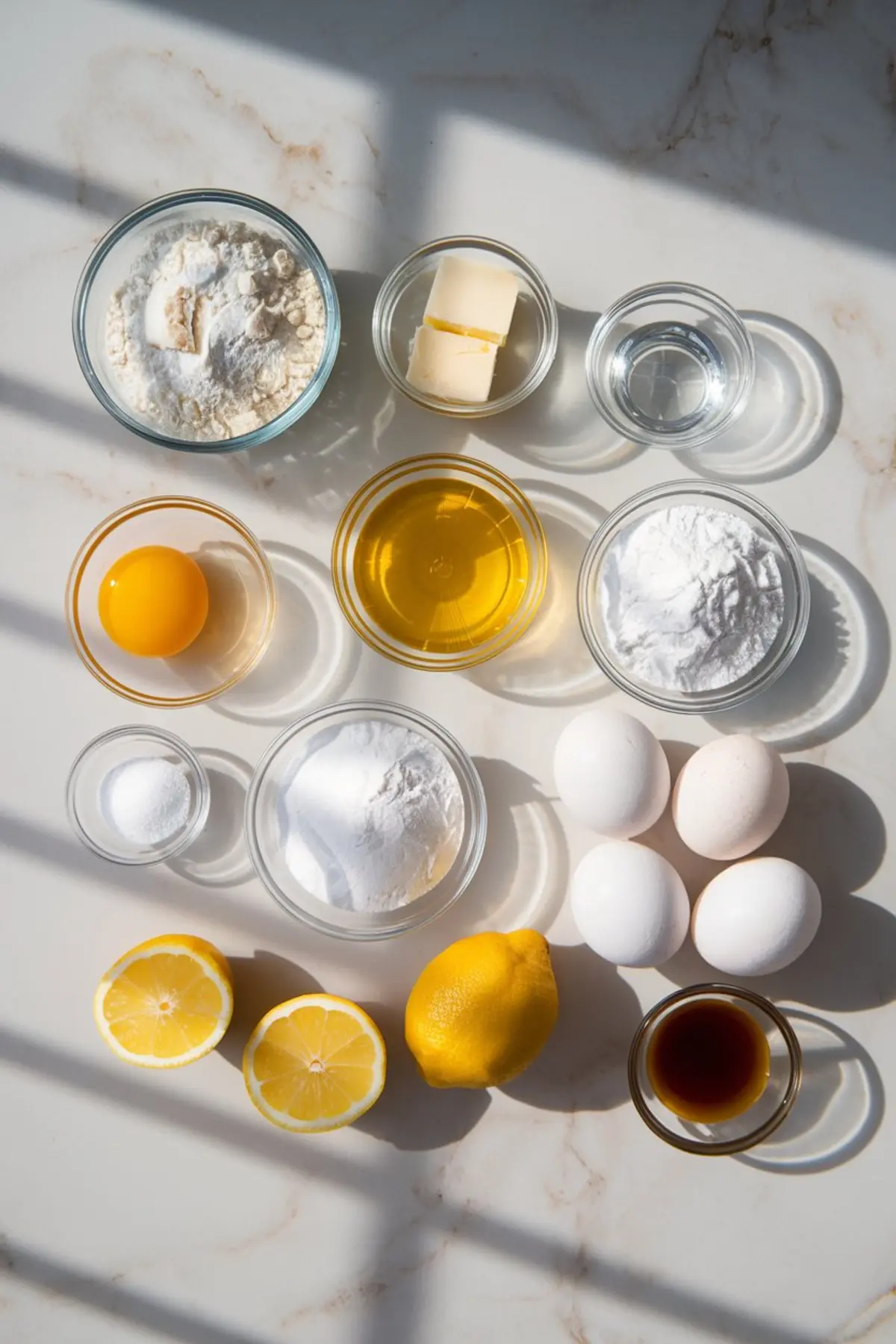You don’t bring this tart to a casual coffee.
This is the dessert you make when you want to say something without raising your voice. When someone doubts your baking or when the weather is gloomy and you need a reminder that brightness can be baked.
This Lemon Meringue Tart is sharp and buttery with just enough sweetness to soften the blow. It has structure. A crisp base, a silky curd that doesn’t weep, and a meringue that stands tall even in a crowded fridge. That’s what you’re going to learn today — how to make a confident tart that holds its shape and delivers a bold lemon flavor with no apologies.
I’ll walk you through how to build that crisp crust, balance the curd so it’s never eggy or bland, and make meringue that doesn’t slump. You’ll finish with something that not only tastes right but looks right. It slices clean. It holds up on the plate. It tells a story.

Building a Crust That Doesn’t Crumble
Start with cold butter. I cube mine and keep it in the freezer while I prepare everything else. The flour, powdered sugar, and a touch of salt come together in the food processor.

Once the butter pulses in, you’re looking for that sandy texture—nothing smooth, just enough hold when pressed between your fingers.
The egg yolk adds richness and binds things together. A tablespoon or two of cold water finishes the dough. I stop the moment it clumps. Anything more, and you lose that flaky edge.
Wrap it tight, let it chill. I always give it the full 30 minutes. The dough needs that time to rest before rolling. Otherwise, it’ll shrink in the oven.

Lemon Curd That Actually Tastes Like Lemon
The key to this curd is the balance of whole eggs and yolks. Too many yolks, and it becomes heavy. Too few, and the curd loses depth.
You want lemon juice, freshly squeezed. No bottled shortcut here. The acid and zest do the heavy lifting. I don’t skip the straining step either. It’s what gives the filling that clean, smooth finish without any flecks of cooked egg or zest to distract you.

Once thickened over low heat, add the butter off the heat. Let it melt slowly into the warm curd. Stir gently. No whipping, just coaxing everything into place.
Pour into the baked shell and chill. This is the part people rush. Don’t. Give it at least three hours in the fridge so it slices clean and doesn’t puddle on the plate.
How I Make Meringue That Doesn’t Cry or Collapse
Egg whites must be room temperature. I’ve learned that the hard way.
Start whipping them with a pinch of cream of tartar. Then add the sugar gradually. I mean gradually. One tablespoon at a time. This helps the sugar dissolve completely so the meringue stays glossy and doesn’t leak later.
I don’t always add vanilla, but if I do, I keep it subtle. Just enough to round out the sharpness of the lemon.
I pipe or spoon it over the chilled tart, spreading it all the way to the crust to seal it. That edge-to-edge cover prevents weeping and keeps the curd underneath from drying out.
A kitchen torch adds that deep toast flavor you can’t get any other way. A broiler works too — just don’t walk away.
Serving, Storing, and Holding Its Own on the Table
Serve the tart cold but not straight from the fridge. I let it sit at room temperature for 15–20 minutes before slicing. The filling softens slightly, and the flavors come alive.
If there are leftovers (rare), I loosely tent the tart with foil. Never use plastic wrap. It clings to the meringue and ruins the peaks.
This tart holds well for up to two days, but honestly, it’s best the same day the meringue goes on. That’s when the textures hit just right — crisp crust, smooth curd, and cloud-like topping.
Final Thoughts — Save This Lemon Meringue Tart Recipe to Your Pinterest
You now know how to make a Lemon Meringue Tart that doesn’t shrink, slump, or disappoint.
It has layers of texture, each one distinct but working together. This is not a background dessert. It’s the kind you bring out when something needs to be said with clarity.
Pin this recipe now to keep it handy for your next gathering, celebration, or stubborn mood.
And if you make it, leave a comment below. Tell me how it turned out. Ask your questions. Let’s turn this into a little corner of lemon lovers swapping tips and stories.
More Lemon Dessert Ideas You’ll Love:
• Lemon Possets – simple, chilled, creamy lemon desserts
• Greek Yogurt Lemon Bars – lighter bars with a soft tang
• Raspberry Lemon Chiffon Pie – airy, fruit-forward tart
• Lemon Cream Puffs – pastry meets lemon cloud
Lemon Meringue Tart

A bright and buttery slice with a crisp crust, smooth lemon curd, and toasted meringue topping.
Ingredients
- FOR THE TART CRUST
- 1 1/4 cups (160g) all-purpose flour
- 1/2 cup (115g) unsalted butter, cold and cubed
- 1/4 cup (30g) powdered sugar
- 1/4 teaspoon salt
- 1 large egg yolk
- 1–2 tablespoons cold water
- FOR THE LEMON CURD FILLING
- 4 large egg yolks
- 2 large eggs
- 3/4 cup (150g) granulated sugar
- 1 tablespoon lemon zest (about 2 lemons)
- 2/3 cup (160ml) fresh lemon juice
- 1/2 cup (115g) unsalted butter, cubed
- Pinch of salt
- FOR THE MERINGUE
- 4 large egg whites
- 1/2 cup (100g) granulated sugar
- 1/4 teaspoon cream of tartar
- 1/2 teaspoon vanilla extract (optional)
Instructions
- MAKE THE TART CRUST: In a food processor, combine the flour, powdered sugar, and salt. Pulse a few times to mix. Add the cold cubed butter and pulse until the mixture resembles coarse crumbs. Add the egg yolk and one tablespoon of cold water. Pulse until the dough begins to come together, adding the second tablespoon of water only if needed.
- CHILL AND PREPARE THE DOUGH: Turn the dough onto a lightly floured surface and shape it into a disc. Wrap tightly in plastic wrap and chill in the refrigerator for 30 minutes.
- ROLL AND BLIND BAKE THE CRUST: Preheat the oven to 350°F (175°C). Roll the chilled dough into a circle large enough to fit a 9-inch tart pan. Press the dough into the pan, trimming any excess, and prick the bottom with a fork. Line with parchment paper and fill with pie weights or dried beans. Bake for 15 minutes, then remove the weights and bake for an additional 10 minutes until the crust is lightly golden. Allow to cool completely before filling.
- PREPARE THE LEMON CURD: In a medium saucepan, whisk together the egg yolks, whole eggs, sugar, lemon zest, and lemon juice. Cook over medium heat, stirring constantly with a heatproof spatula or wooden spoon, until the mixture thickens and coats the back of the spoon, about 8–10 minutes.
- FINISH THE CURD: Remove the saucepan from heat and stir in the cubed butter and a pinch of salt until fully melted and smooth. Strain the curd through a fine mesh sieve into a clean bowl to remove any cooked egg bits or zest, if desired.
- FILL AND CHILL THE TART: Pour the warm curd into the cooled tart crust. Spread evenly, then chill in the refrigerator for at least 3 hours or until set.
- MAKE THE MERINGUE: In a clean, dry bowl, beat the egg whites and cream of tartar using a hand or stand mixer on medium-high speed until soft peaks form. Add the sugar gradually, one tablespoon at a time, beating continuously until stiff, glossy peaks form. Beat in vanilla extract, if using.
- TOP AND TOAST THE MERINGUE: Spoon or pipe the meringue over the chilled lemon curd, spreading it to the edges to seal completely. Use a kitchen torch to gently toast the meringue until golden brown. If using a broiler, place the tart under the broiler for 30–60 seconds, watching closely to prevent burning.
- CHILL BEFORE SERVING: Return the tart to the refrigerator for 15–20 minutes before slicing to help the layers set.
Notes
Use fresh lemon juice for best flavor. The tart is best served the same day the meringue is added, but leftovers can be stored in the fridge for up to 2 days. Avoid covering tightly with plastic wrap, as it may stick to the meringue.
Nutrition Information
Yield
10Serving Size
1Amount Per Serving Calories 262Total Fat 11gSaturated Fat 5gTrans Fat 0gUnsaturated Fat 5gCholesterol 208mgSodium 209mgCarbohydrates 31gFiber 1gSugar 16gProtein 9g

